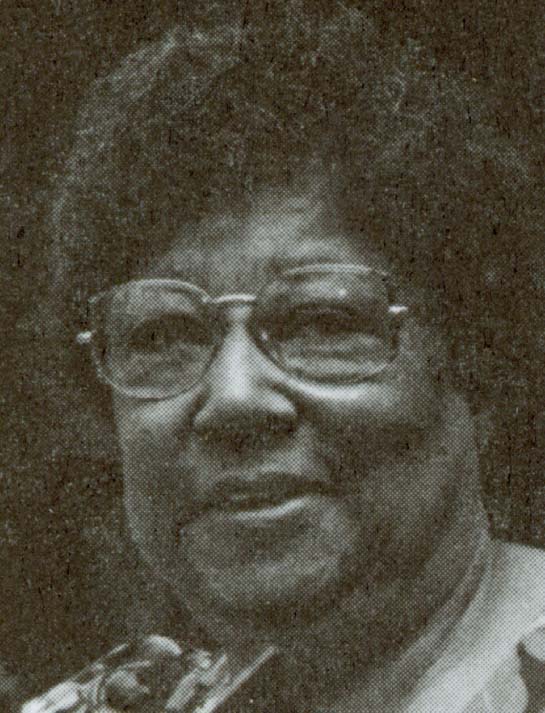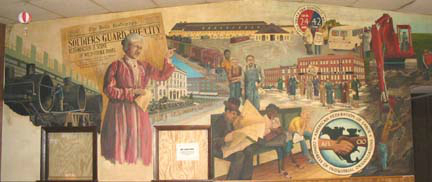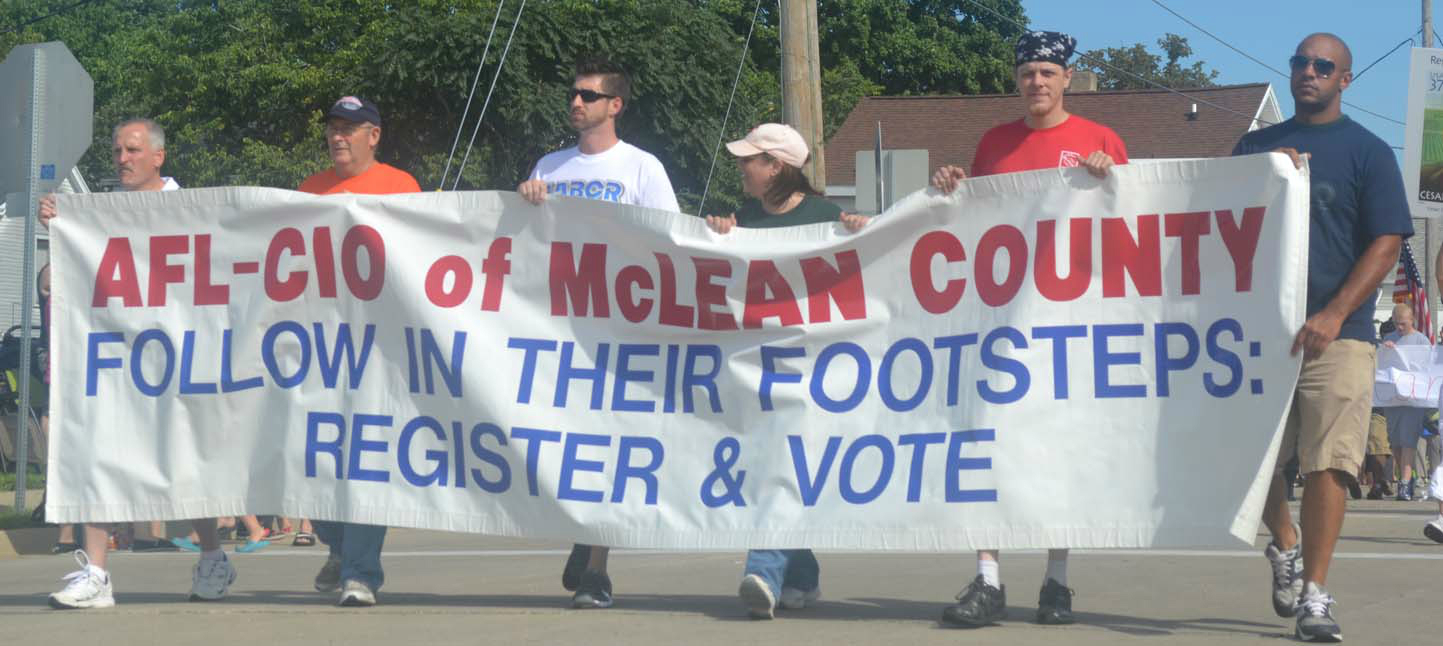
|
| Ruth Waddell helped integrate local industry in the early 1950s. |
|
During World War II local unions took a no-strike pledge, which was honored for the war's duration. Union construction trades donated building a canteen at the C&A depot, which served coffee and donuts to military personnel on passing trains. The Trades & Labor Assembly also donated $400 monthly to the canteen's operation. Although not consistent, many unions reported during the war that 100 percent of their membership was on payroll deduction for war bonds (7,500 members, 4).
War brought other unexpected changes to the workplace -- women and African Americans in the factory. Williams began hiring women as military draft depleting the workforce, Williams losing 383 employees to the armed forces. Williams initially hired 56 women in early 1943, using training films to acquaint them with plant processes ("56 women," 4).
The other group hired was African American workers. Although the new female hires joined Machinists Lodge 1000, the African American workers were not allowed to participate in the union. They were kept segregated from the rest of the workforce, doing mainly hand filing and finishing work, and only worked on defense contracts. A. Phillip Randolph, Brotherhood of Sleeping Car Porters president, had successfully lobbied President Roosevelt in 1941 to end discriminatory hiring practices. Roosevelt issued an executive order against racial discrimination in war contracts. Ruth Waddell, who worked at Williams during the war, remembered that "some people had problems with us being there," but she and other African American workers enjoyed the higher pay and an opportunity to do work usually denied to them. As soon as the war contract work ended, all the African American workers were laid off (Matejka, 2).
The immediate post-war period saw a nationwide strike wave, as workers tried to equalize wages after wartime wage and price freezes. Bloomington railroaders participated in their union's 1946 national strikes. The first post-war walk-out came less than six weeks after the war's end.
Machinists Lodge 1000 members at Meadows walked out on October 16, 1945, after the company posted its interpretation of a War Labor Board statement, which set a retroactive pay increase to February 1, 1944. Workers disputed the company's interpretation and 200 machinists walked out at 11 a.m. Within two days the plant was in production again, after the company agreed to share payroll data with the union to insure the wages were properly apportioned.
Another post-war dispute did not involve any work stoppage, but a management change. After Detroit's Eureka Company merged with Williams in May 1945, retained William A. Matheson as general manager. In February 1947 the company "relieved Matheson of his duties." The next month Machinist Lodge 1000 sent a letter to the company's board of directors, asking for Matheson retention. The union wrote that workers had a "very high opinion of Mr. Matheson and our problems have always been fairly adjusted when we were permitted to meet with him ("Machinists want Matheson," 4).
After World War II the industrial unions were fairly well-established. The Bakery Workers at Beich Candy and the Machinists at Eureka-Williams and Meadows regularly negotiated contracts, occasionally with a strike, but usually without. When General Electric opened a Bloomington plant in 1954 and Modine in 1964, Machinists Lodge 1000 organized their workforces, as did the United Rubber Workers when Firestone opened its Normal facility in 1965. Other companies successfully avoided unionization. These local unions, although always receptive to organizing new workplaces, spent much of their energy taking care of individual grievances within their already organized workplaces and negotiating contracts.
Eureka-Williams surpassed the C&A rail shops as McLean County's largest industrial employer. The Alton Railroad merged with the Gulf, Mobile & Ohio in 1947. This line became one of the nation's first Class 1 railroads to dieselize. The army of machinists, boilermakers, blacksmiths and sheet metal workers who kept the steam giants running were quickly redundant. Those with seniority found work maintaining the less labor intensive diesels or in building and repairing rail cars, which continued in Bloomington through the 1960s. Some railroaders transferred their skills to the new industrial power centers of the community.
The local labor movement was not as militant as an earlier era, which ran members for office and sponsored Socialist speakers at Labor Day event. Labor Day festivities were private, family affairs in the 1950s, not public festivals for labor to declare its power. Although still active in local community affairs and encouraging members to vote at election time, much union activity, especially for factory workers, centered around the shop floor. Contract negotiations were major milestones, but so was more immediate union representation, tending to member's individual grievances and complaints over shop floor conditions.
At the heart of the postwar system of collective bargaining lay the union contract's increasingly elaborate provisions governing work rules, discipline, and disposition of workers' grievances. Indeed, it was in the matter of grievances that the modern union daily reaffirmed its vital role in its members' lives. ...Matters relating to work rules, discipline, job assignment, and grievances had to remain on the level of the local plant and the local union. It was here that managers and workers struggled to define the content and character of the work performed. Even with the relatively amicable system of collective bargaining in the forties and fifties, the shop floor remained contested terrain (Zieger, 154).'
Many women remained in the local industrial workforce after the work; increasingly in local plants, women did assembly work, while men operating machinery and were trained as tool and die makers, plant electricians and other skilled positions. Factory jobs were economic opportunities for women, but still created strain with expectations that they would continue as homemakers too.
June Penn worked for Sylvania during World War II and for Admiral assembling television sets after the war. She noted that "I did the cooking and took care of the house and the children." The additional paycheck meant enough to "pay for the sitter and buy enough groceries for the whole week. ...The cupboards were full after that." Juggling a full-time work schedule, maintaining a home and caring for children created pressure on women workers. She remembers her supervisor at Admiral gathering the women one day, complaining, "there's just too much absenteeism. He said, when my child is sick or something has to be done, my wife takes care of it.' We're all looking at him, like duh, what a profound statement to make (Penn).'"
Larry Yeast remembered pay differentials for men and women, and instead proposed job titles, paying workers according to their job classification, not their gender.
I always felt that if you was a member you should have the full rights, if you were a woman member. ...In reading the labor laws, ...I realized we were vulnerable and so I proposed when the contract change came up that we change the titles of the jobs. We had light assembly and heavy assembly, because you then couldn't distinguish between men and women, and there was a little resentment both on the committee and the company for trying to mess around with that. I told them that they were going to have to change it or you are going to be it trouble. They recognized it (Yeast).
In May 1950 Meadows workers struck for a month, eventually winning a five cent an hour raise, with an additional three cents the in January 1951. They also received a $15 retroactive pay lump sum with their return to work. The union workers had originally demanded an eight cent an hour increase, the company refusing any. The workers got that increase, but spread over two years (Meadows workers, 4).
When General Electric opened their $5 million plant on Bloomington's east side in July 1954, the plant opened non-union. The plant expected to employ at least 1,000 workers and exceeded that number. By 1954's end Machinist Lodge 1000 filed with the National Labor Relations Board to represent GE's workers.
A complicated set of NLRB-supervised elections followed. Within a few weeks of Lodge 1000's filing, the International Union of Electrical, Radio and Machine Workers, a CIO union, also filed for representation rights. Two AFL unions filed to represent maintenance workers in the plant, the Operating Engineers wanting jurisdiction over the steam boilers and the International Brotherhood of Electrical Workers wanting to organize maintenance electricians and helpers ("4 Unions," 4).
General Electric opposed the unionization effort. In public statements it promised fair treatment to all workers, union or not, and promised that non-union employees would receive the same benefits as those already unionized elsewhere. Rial Herreman, the company's personnel director, said "GE has respect for the individual;" and applies the "golden rule" to its workplace relationships ("GE can't see," 4).
On June 10, 1955 an NLRB representational election was held, with 447 workers voting. Lodge 1000 received 223 votes, "no union" 193 votes and the IUER&M 24 votes. GE challenged the results before the NLRB as inconclusive. In September 1955 the NLRB certified Lodge 1000 as the official bargaining agent for Bloomington GE workers. By the end of October the newly recognized union negotiated a 5-year contract patterned after GE's national agreements, granting workers an 18 percent raise over the contract's life.
Meanwhile another battle was taking place in local workplaces -- racial integration. African Americans who briefly enjoyed higher-paying factory jobs during wartime wanted an opportunity. A married couple, Oscar and Ruth Waddell, helped open the door for African Americans at local factories.
Oscar, a World War II veteran, worked as a bus mechanic for National City Lines in Bloomington before the war. His father had a connection to the Williams firm, but in a servant role, serving as C.U. Williams' chauffeur. After the war he took a sweeper job at Meadows. One day a hydraulic press operator did not report for work; Oscar had studied the process for weeks and quickly stepped into position. He ran the machine and the company allowed him to continue. In 1955 he was hired by GE and retired from that firm in 1982 (Matejka, 9).
Ruth Waddell had worked at Eureka during the war in a segregated area, completing war contracts. After the war she worked housekeeping at Saint Joseph Hospital and in private homes. When GE came to town she took their initial test in 1953 and was hired, but was never called to report to work. Faithfully she checked in at the company office weekly, yet was always told there was no opening.
Finally frustrated, she confronted the company in 1954. "They always had an excuse. I sat down in the chair and said, either put me to work or I'm going to sit here until you do.'" She was finally given a job after her protest.
The Waddells became active supporters of Lodge 1000 at GE, both meeting workers "back in the alley" in Bloomington and in area small towns, to sign them up for union membership. Both were elected as union stewards at GE. "I was a good steward. They'd come across the factory floor to get me to fight for them. I demanded respect." Both reported discrimination at various times, particularly when they attempted to build a home. Despite an excellent savings record, no local bank would lend them the necessary fund. A GE manager intervened and vouched for them, allowing them to construct a solid brick home.
Both heard derogatory comments on the factory floor, but refused to accept them. Particularly Ruth challenged any comment she considered inappropriate. "Ever since grade school I'd fight if you going to call me a name. I demanded respect. I never took anything off the bosses or anyone (Waddell)."
Machinists Lodge 1000 successfully organized city water workers, American Furnace and Foundry and General Box Company in the 1950s. Union organization was not for all workers. In 1958 Portable Elevator workers turned down union representation by Machinists Lodge 1000 and later Beer Nut employees rejected Bakery Workers representation. General Electric remained an "open shop," refusing nationally to sign any agreement which mandated union membership. This created tension and division within the workplace there. George and Eloise Drye both refused to join Lodge 1000 at GE. Feelings were often bitter between members and non-members, particularly after a hard fought strike in 1969-70, when non-union workers continued plant operations. Eloise Drye recounted that "The ones that belonged to the union just ostracized the ones that didn't (strike) and went to work. My belief is you shouldn't have to pay the union for the privilege of going to work (Drye)." Ruth Waddell also remembered "bitterness and hard feelings" between union and non-union workers at GE. Non-members enjoyed the protections, benefits and wage increases of the union-negotiated agreements; they could not participate in union elections and contract votes.
Larry Yeast found this divided workforce a hindrance when negotiating with GE. The union was often in a weak position because a large proportion of the plant did not belong:
Now we had a lot of trouble with General Electric. We had an awful weak contract, the first one. ...The language wasn't worth a dime, and when I went in there I just was raising Cain one time to Ehrman (plant manager Dick Ehrman) that the contract wasn't worth the paper it was printed on. He said, You're lucky I have you anything.'
I said, What do you mean you gave?' And he said, I just mean that.' I that time there were probably 800-900 people out there and we had a little over half of them as members. He said, Do you remember how many members you had when this contract was signed?' And I says, Yeah.' Well, he says, I don't think you do. You had 108 members out of 800 people.' ...I went down to the office and I asked the financial secretary, I said, How many members do we have there?' And he said, Well, I don't know.' I said, Count them.' And he looked back and we had about 108 people on (dues) check-off (Yeast).
|



